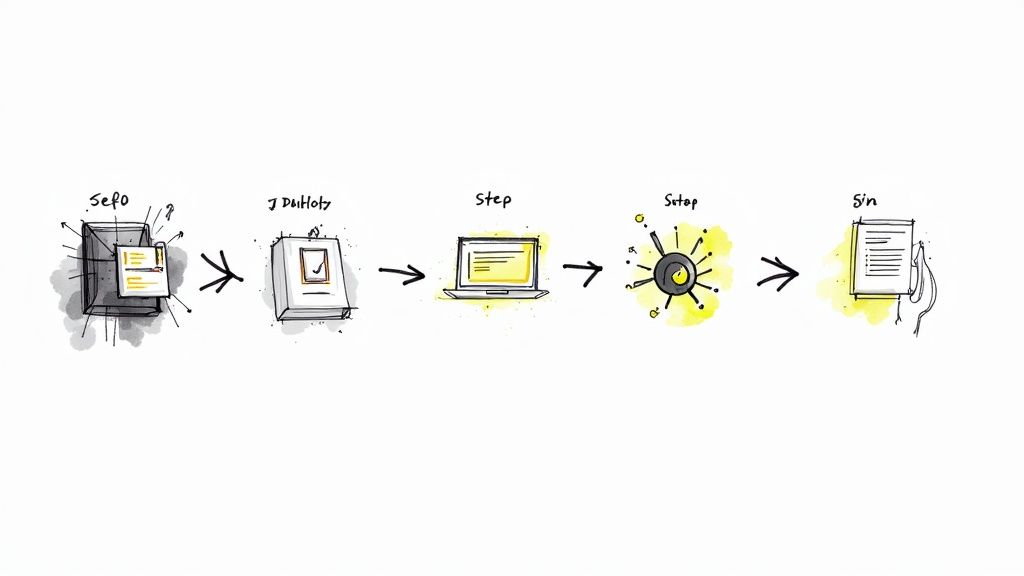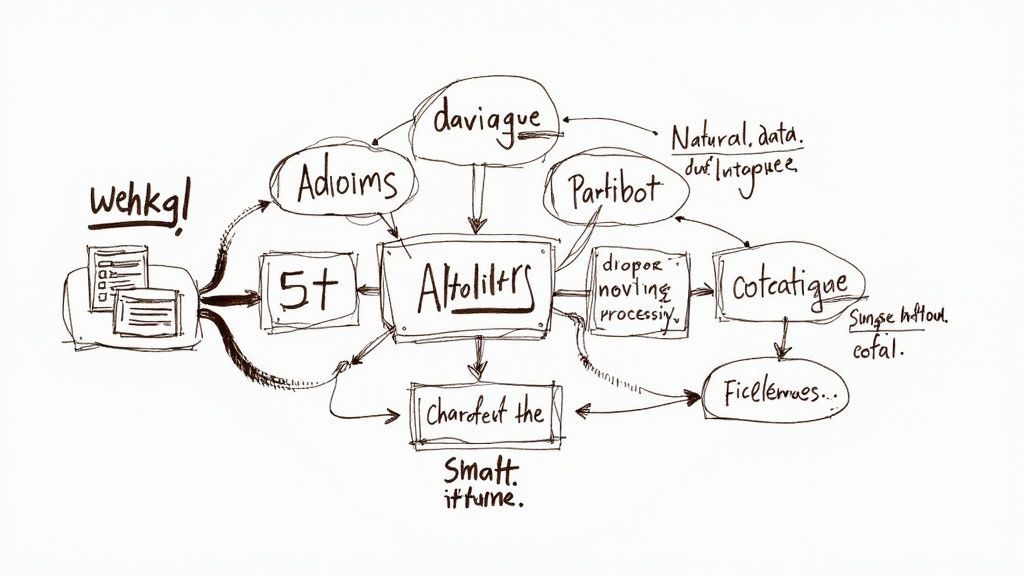How to Build an AI Chatbot: Step-by-Step Guide
Understanding the Evolution of AI Chatbots

The story of AI chatbots begins in the 1960s with ELIZA, created by MIT professor Joseph Weizenbaum. This early chatbot used basic pattern matching and word substitution to simulate conversation. While ELIZA couldn't truly understand language, it showed what was possible and sparked interest in developing more advanced chatbots. The focus at this stage was simply making machines appear to hold a conversation, rather than enabling real comprehension.
Advancements in AI Chatbot Technology
A major step forward came in the 1990s with A.L.I.C.E., which introduced AIML (Artificial Intelligence Markup Language) for more structured interactions. A.L.I.C.E. could maintain basic conversations, share information about itself, and respond more naturally to users. This set new standards for how chatbots could process and respond to human language.
The real breakthrough arrived in 2010 with Apple's Siri, which brought natural language interfaces to everyday devices. Siri changed how people interacted with technology and inspired similar AI assistants like Google Assistant, Microsoft's Cortana, and Amazon's Alexa. These AI helpers have become essential tools that many people use daily for various tasks.
The Impact and Future of Chatbots
Businesses are rapidly adopting chatbot technology, with projections showing a 34% increase in usage by 2025. Currently, 60% of B2B and 42% of B2C companies already use chatbot software to improve their operations. These numbers reflect how valuable chatbots have become as business tools.
The benefits of chatbots are clear and measurable. They can cut customer support costs by 30% and may save businesses $8 billion overall. Most impressively, chatbots can handle 80% of common questions, reducing the cost per interaction from$ 5-12 with human agents to just $1 with automated systems. As AI models like GPT-4 continue to improve, chatbots are becoming even better at natural conversation. This makes learning to create effective AI chatbots an essential skill for modern businesses. The chatbot market is expected to grow from$ 4.7 billion in 2020 to $15.5 billion by 2028, showing strong demand for efficient AI solutions. Both voice and text-based chatbots will continue to shape how businesses interact with their customers in the years ahead.
Crafting Your Chatbot Strategy for Maximum Impact

Building an effective AI chatbot starts with careful planning and strategy. Before writing a single line of code, you need to map out exactly how your chatbot will serve your business and customers. A clear strategy helps ensure your chatbot will actually solve real problems and provide genuine value to users.
Defining Your Chatbot's Purpose and Scope
Start by getting specific about what your chatbot will do. Will it help customers track orders, schedule appointments, or answer common product questions? A retail chatbot might focus on order status updates and return policies, while a restaurant chatbot could handle reservations and menu inquiries. Having crystal clear goals makes it much easier to build the right features.
It's also important to set boundaries around what your chatbot will and won't handle. For instance, you might start with just order tracking before expanding to returns and refunds. This focused approach lets you test and refine core functions before adding more capabilities. Think of it like learning to walk before you run - master the basics first, then gradually expand what your chatbot can do based on real user needs.
Understanding Your Target Audience
Who exactly will be using your chatbot? Their needs and preferences should shape every aspect of its design. A chatbot for tech-savvy millennials can use casual language and emojis, while one for business professionals should maintain a more formal tone. Pay attention to how your audience typically communicates, what devices they use, and what problems they're trying to solve. This helps you create interactions that feel natural and helpful rather than frustrating.
Setting Measurable Success Metrics
You need concrete ways to measure if your chatbot is actually helping your business. Choose specific metrics that align with your goals - like the percentage of customer questions resolved without human help, average response time, or user satisfaction ratings. If you want to reduce support costs, track how many tickets the chatbot handles versus your support team. For lead generation, measure conversion rates from chat interactions. Clear metrics let you spot problems early and keep improving your chatbot's performance over time based on real data rather than guesswork.
Selecting the Right Development Approach
Once you have your chatbot strategy in place, you'll need to choose how to build it. This choice affects everything from the features your chatbot can have to how long it will take to develop and what it will cost. You have three main options: no-code platforms, development frameworks, or building a custom solution from scratch. Let's explore what each approach offers.
No-Code Platforms: Quick and Easy Deployment
If you want to get a chatbot up and running quickly without any coding, no-code platforms are your best bet. These tools come with simple drag-and-drop interfaces and ready-made templates that connect to common messaging apps. For example, a local retail store could use Sitebot to create a basic customer service chatbot in just a few hours, with features like GPT-4 powered responses in multiple languages. While these platforms make it easy to start, they may not offer all the custom features or growth potential that some businesses need as they expand.
Development Frameworks: Flexibility and Control
When you need more control over your chatbot's capabilities, development frameworks like Rasa and Dialogflow offer a middle ground. While you'll need coding skills to use them, these frameworks give you the freedom to customize how your chatbot works, connect it to other business tools, and use advanced language processing. A company that wants their chatbot to work directly with their customer database would find this approach useful. Keep in mind that building with frameworks takes more time and technical know-how than using no-code tools.
Custom Solutions: Tailored for Unique Requirements
Sometimes, existing tools just won't meet your needs. Building a custom chatbot gives you complete control over every aspect - from how it processes language to where it stores data. For instance, healthcare providers often choose this route to ensure their chatbots handle patient information according to HIPAA rules. The trade-off? Custom development requires significant time, money, and a team of skilled developers.
Choosing the Best Fit for Your Needs
To pick the right approach, consider these key factors:
| Factor | No-Code Platforms | Development Frameworks | Custom Solutions |
|---|---|---|---|
| Cost | Low | Medium | High |
| Development Time | Short | Medium | Long |
| Customization | Limited | Extensive | Complete |
| Scalability | Limited | Moderate | High |
| Technical Skill | None | Required | Required |
Take time to match these factors against your goals, available resources, and technical capabilities. This careful consideration at the start will help ensure your chatbot project succeeds in meeting your business needs.
Building Your First Conversational Experience

Once you've selected your development path, it's time to focus on creating the actual conversations your AI chatbot will have with users. This process requires both technical expertise and an understanding of how people naturally communicate. You'll need to carefully plan how your chatbot responds to different inputs while keeping interactions smooth and natural.
Designing Natural Conversations
The key to engaging users is making conversations feel authentic and human-like. Just as people exchange greetings, ask questions, and acknowledge each other's responses, your chatbot should follow similar patterns. Start with friendly opening messages like "Hi there! How can I help you today?" Then map out common questions users might ask and prepare clear, helpful responses. Guide the conversation by offering relevant suggestions such as "Would you like to know more about our products?" or "Can I help you find something specific?"
Handling User Inputs Effectively
Users express themselves in many different ways - they might misspell words, use informal language, or phrase their needs indirectly. Your chatbot needs to be smart enough to understand the meaning behind these varied inputs. Natural Language Processing (NLP) techniques can help identify what users want, even when their phrasing isn't perfect. For example, if someone types "I wanna buy a red shoe," the chatbot should recognize that they want to make a purchase and that they're specifically interested in red shoes.
Creating Engaging Dialogue Flows
Good chatbots do more than just answer questions - they maintain meaningful conversations. This means keeping track of what's been discussed and personalizing responses accordingly. If a customer asks about a product and then wants to know about shipping, the chatbot should remember which item they're interested in and provide relevant shipping details. The chatbot can also use information from previous interactions, like past purchases, to make helpful suggestions. These personal touches make conversations more natural and useful.
Managing Context and Edge Cases
As conversations become more complex, keeping track of context becomes crucial. Consider a scenario where a customer asks about product availability, switches to discussing store hours, then returns to their original product question. Your chatbot needs to handle these topic changes smoothly while remembering important details from earlier in the conversation. It's also essential to plan for unexpected situations. When users ask questions the chatbot can't answer, have a backup plan ready - perhaps offering to connect them with a real person or suggesting different ways to ask their question. While these situations can be challenging, handling them well is what makes a chatbot truly helpful and user-friendly.
Optimizing Your Chatbot's Intelligence

Creating a basic chatbot is just the beginning. To make it truly useful, you need to continuously improve its intelligence through testing, refinement and optimization. Let's explore practical techniques that can help evolve your chatbot from a simple Q&A bot into a smart, capable assistant that provides real value to users.
Enhancing Natural Language Understanding (NLU)
The key to a smarter chatbot lies in its ability to understand how people naturally communicate. Think about how customers phrase the same question in different ways - "What are your store hours?" versus "When are you open?" A well-designed chatbot needs to recognize these variations and respond appropriately. This requires implementing solid NLU capabilities like entity recognition to identify important details and intent classification to understand what users are trying to accomplish. By analyzing actual user conversations and feeding that data back into training, your chatbot can steadily get better at interpreting different ways people express the same needs.
Managing Complex Conversations and Context
Beyond understanding single questions, effective chatbots need to handle multi-part conversations while maintaining context. Consider a customer asking about a product, then shipping options, then returns - the chatbot must remember which product they're discussing throughout. This requires thoughtful conversation design, often using state tracking or dialogue management systems. Connecting your chatbot to your company's databases and CRM also helps it access relevant details to personalize each interaction based on context.
Leveraging Analytics and User Feedback
How can you tell if your chatbot is actually helping users? The data will tell you. Track key metrics like user satisfaction scores, successful conversation completion rates, and how often the bot has to fall back to default responses. Just as valuable is direct user feedback - regularly reviewing user comments helps spot gaps in the chatbot's knowledge and opportunities to improve its responses. This combination of quantitative and qualitative data enables steady, focused improvements.
Implementing Machine Learning Effectively
While machine learning is essential for chatbot intelligence, success requires more than just applying ML algorithms. You need high-quality training data that represents real user needs, careful model selection based on your specific requirements, and ongoing evaluation. Start with diverse example conversations covering different user intents. Choose the right type of ML model - whether rule-based, retrieval-based, or generative - based on what your chatbot needs to accomplish. Then continuously monitor performance and retrain with new data to help your chatbot learn and adapt over time. This systematic approach to ML implementation, combined with regular refinement based on actual usage, helps create a chatbot that consistently delivers value through better understanding and more helpful responses.
Scaling and Measuring Business Impact
Creating an effective AI chatbot requires more than basic functionality - it needs a well-planned strategy for growth and measuring real business results. Start by identifying where your chatbot can make the biggest difference, whether that's answering common questions, providing product guidance, or processing orders. From there, develop a clear plan to expand those capabilities while carefully tracking performance.
Identifying Key Performance Indicators (KPIs)
Choosing the right metrics helps show exactly how your chatbot supports business goals. If you want happier customers, track satisfaction scores and positive comments. For improved support efficiency, measure ticket volume reduction and faster response times. The key is picking KPIs that clearly demonstrate impact and point to opportunities for improvement.
Tracking and Analyzing Chatbot Performance
Put systems in place to monitor key data like conversation flows, user interactions, and other relevant metrics. Today's analytics tools show you exactly how your chatbot performs in real-time. You can spot common questions, identify problem areas, and see what works best. This helps you continuously improve the conversation design and responses based on actual user behavior.
Scaling Your Chatbot Across Multiple Channels
Once your chatbot proves valuable, expand it to reach customers wherever they are - whether that's your website, social media, messaging apps, or email. Remember that each channel has unique requirements. A chatbot that works great on your website might need adjustments for more concise platforms like WhatsApp. Focus on providing a smooth, consistent experience across all touchpoints.
Calculating Return on Investment (ROI)
Show the financial impact of your chatbot by comparing costs versus benefits. Add up expenses like development, maintenance and training, then measure against gains from lower support costs, increased sales, better customer retention and other improvements. For example, if your chatbot handles 80% of routine questions, calculate the savings from reduced support staff hours. This clear ROI data helps justify further investment in expanding capabilities.
Ready to transform your customer experience and boost your business with a powerful AI chatbot? Start building with Sitebot today and unlock the potential of personalized, intelligent conversations. Create your free Sitebot account now!


